2019 MASERATI GRANTURISMO CONVERTIBLE warning light
[x] Cancel search: warning lightPage 252 of 296
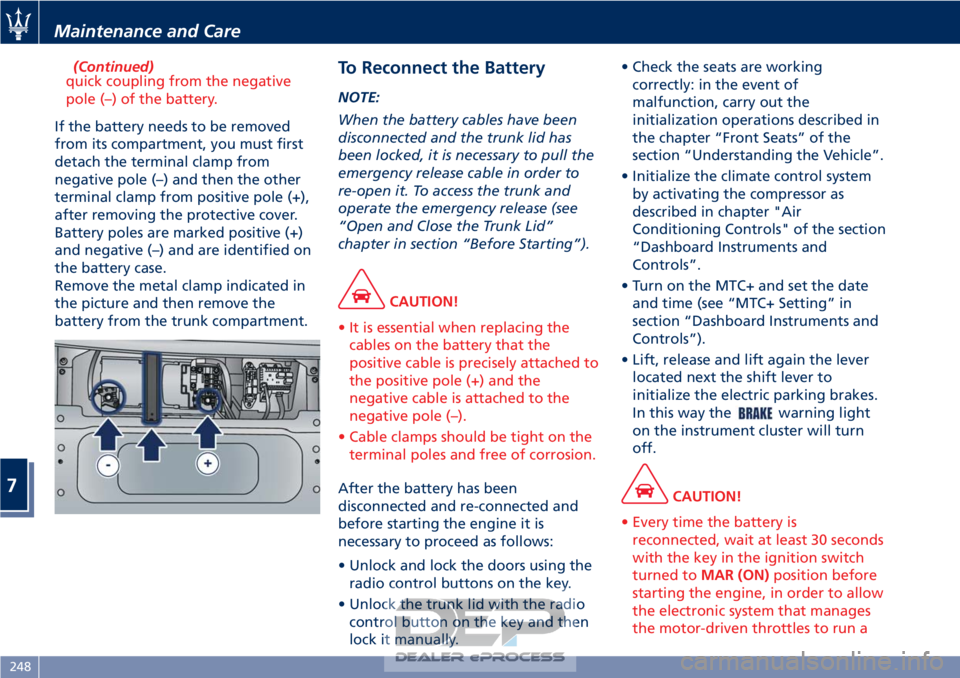
(Continued)
quick coupling from the negative
pole (–) of the battery.
If the battery needs to be removed
from
its compartment, you must first
detach the terminal clamp from
negative pole (–) and then the other
terminal clamp from positive pole (+),
after removing the protective cover.
Battery poles are marked positive (+)
and negative (–) and are identified on
the battery case.
Remove the metal clamp indicated in
the picture and then remove the
battery from the trunk compartment.
To Reconnect the Battery
NOTE:
When the battery cables have been
disconnected and the trunk lid has
been locked, it is necessary to pull the
emergency release cable in order to
re-open it. To access the trunk and
operate the emergency release (see
“Open and Close the Trunk Lid”
chapter in section “Before Starting”).
CAUTION!
• It is essential when replacing the cables on the battery that the
positive cable is precisely attached to
the positive pole (+) and the
negative cable is attached to the
negative pole (–).
• Cable clamps should be tight on the terminal poles and free of corrosion.
After the battery has been
disconnected
and re-connected and
before starting the engine it is
necessary to proceed as follows:
• Unlock and lock the doors using the radio control buttons on the key.
• Unlock the trunk lid with the radio control button on the key and then
lock it manually. • Check the seats are working
correctly: in the event of
malfunction, carry out the
initialization operations described in
the chapter “Front Seats” of the
section “Understanding the Vehicle”.
• Initialize the climate control system by activating the compressor as
described in chapter "Air
Conditioning Controls" of the section
“Dashboard Instruments and
Controls”.
• Turn on the MTC+ and set the date and time (see “MTC+ Setting” in
section “Dashboard Instruments and
Controls”).
• Lift, release and lift again the lever located next the shift lever to
initialize the electric parking brakes.
In this way the
warning light
on the instrument cluster will turn
off.
CAUTION!
• Every time the battery is reconnected, wait at least 30 seconds
with the key in the ignition switch
turned to MAR (ON) position before
starting the engine, in order to allow
the electronic system that manages
the motor-driven throttles to run a
Maintenance and Care
7
248
Page 253 of 296
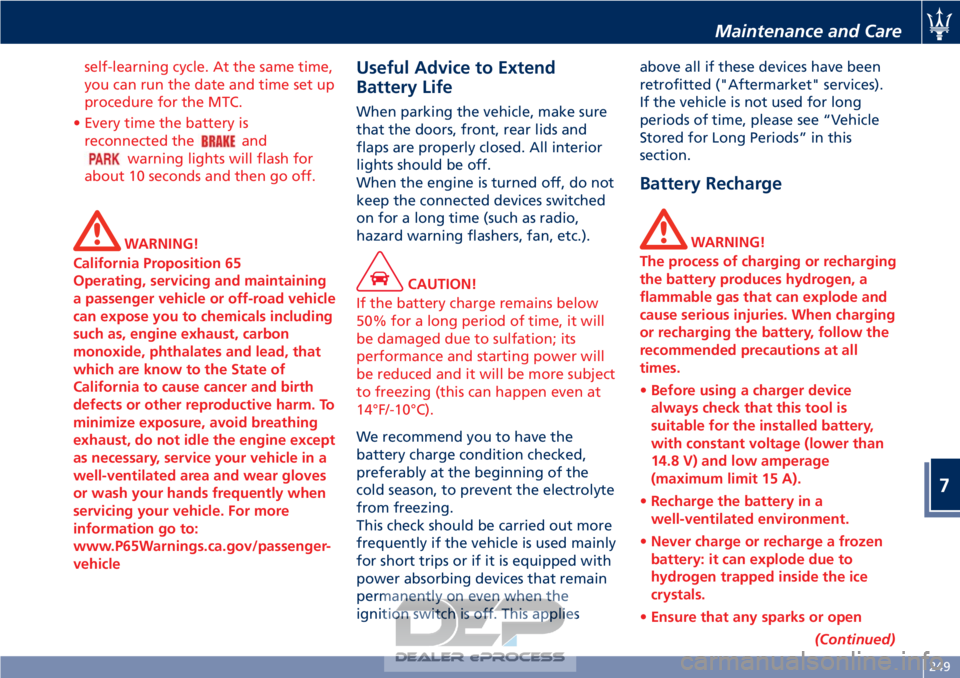
self-learning cycle. At the same time,
you can run the date and time set up
procedure for the MTC.
• Every time the battery is reconnected the
and
warning lights will flash for
about 10 seconds and then go off.
WARNING!
California Proposition 65
Operating, servicing and maintaining
a passenger vehicle or off-road vehicle
can expose you to chemicals including
such as, engine exhaust, carbon
monoxide, phthalates and lead, that
which are know to the State of
California to cause cancer and birth
defects or other reproductive harm. To
minimize exposure, avoid breathing
exhaust, do not idle the engine except
as necessary, service your vehicle in a
well-ventilated area and wear gloves
or wash your hands frequently when
servicing your vehicle. For more
information go to:
www.P65Warnings.ca.gov/passenger-
vehicle
Useful Advice to Extend
Battery Life
When parking the vehicle, make sure
that the doors, front, rear lids and
flaps are properly closed. All interior
lights should be off.
When the engine is turned off, do not
keep the connected devices switched
on for a long time (such as radio,
hazard warning flashers, fan, etc.).
CAUTION!
If the battery charge remains below
50% for a long period of time, it will
be damaged due to sulfation; its
performance and starting power will
be reduced and it will be more subject
to freezing (this can happen even at
14°F/-10°C).
We recommend you to have the
battery
charge condition checked,
preferably at the beginning of the
cold season, to prevent the electrolyte
from freezing.
This check should be carried out more
frequently if the vehicle is used mainly
for short trips or if it is equipped with
power absorbing devices that remain
permanently on even when the
ignition switch is off. This applies above all if these devices have been
retrofitted ("Aftermarket" services).
If the vehicle is not used for long
periods of time, please see “Vehicle
Stored for Long Periods” in this
section.
Battery Recharge
WARNING!
The process of charging or recharging
the battery produces hydrogen, a
flammable gas that can explode and
cause serious injuries. When charging
or recharging the battery, follow the
recommended precautions at all
times.
• Before using a charger device
always check that this tool is
suitable for the installed battery,
with constant voltage (lower than
14.8 V) and low amperage
(maximum limit 15 A).
• Recharge the battery in a
well-ventilated environment.
• Never charge or recharge a frozen
battery: it can explode due to
hydrogen trapped inside the ice
crystals.
• Ensure that any sparks or open
(Continued)
Maintenance and Care
7
249
Page 261 of 296

Bulb Replacement
The signal failure of an external light
(turn signal, low beam and high beam,
license plate light, reverse light, brake
light and rear fog light) is
communicated to the instrument
cluster that displays on the TFT screen
the
oramber warning light
and a text message indicating which
light is faulty.
Front Headlights
The light bulbs of the headlight
clusters are arranged as follows:
1 Bi-Xenon low-beam/high-beam
bulb.
2 Position light and DRL (*) LED.
3 Turn signal light bulb.
4 FTP bulb, headlight flashing.
5 Side marker bulb.
(*) On vehicles for the Canadian
market DRL are always enabled.
CAUTION!
Due to the complexity of the
operation, for the replacement of the
headlight clusters light bulbs, we
recommend that you contact an
Authorized Maserati Dealer .
WARNING!
The headlamps are a type of high
voltage discharge tube. High voltage
can remain in the circuit even with the
headlamp switch and the ignition
switch off. Because of this, you should
not attempt to replace a headlamp
bulb yourself, but take the vehicle to
an Authorized Maserati Dealer for
service.
Tail-Light Clusters Light Bulbs
The taillight bulbs are arranged as
follows:
1 Position light guide LED.
2 Stop light LED.
3 Turn signal LED.
4 Reverse light bulb.
5 Rear fog light bulb.
Tail-Light Clusters Bulbs
Replacement
Most of the lamps of the taillight are
LED powered and cannot be replaced
individually. The only exceptions are
the reverse and the rear fog light
bulbs for which you find below the
replacement procedure.
Contact an Authorized Maserati
Dealer to locate the correct parts and
replace them.
Maintenance and Care
7
257
Page 274 of 296
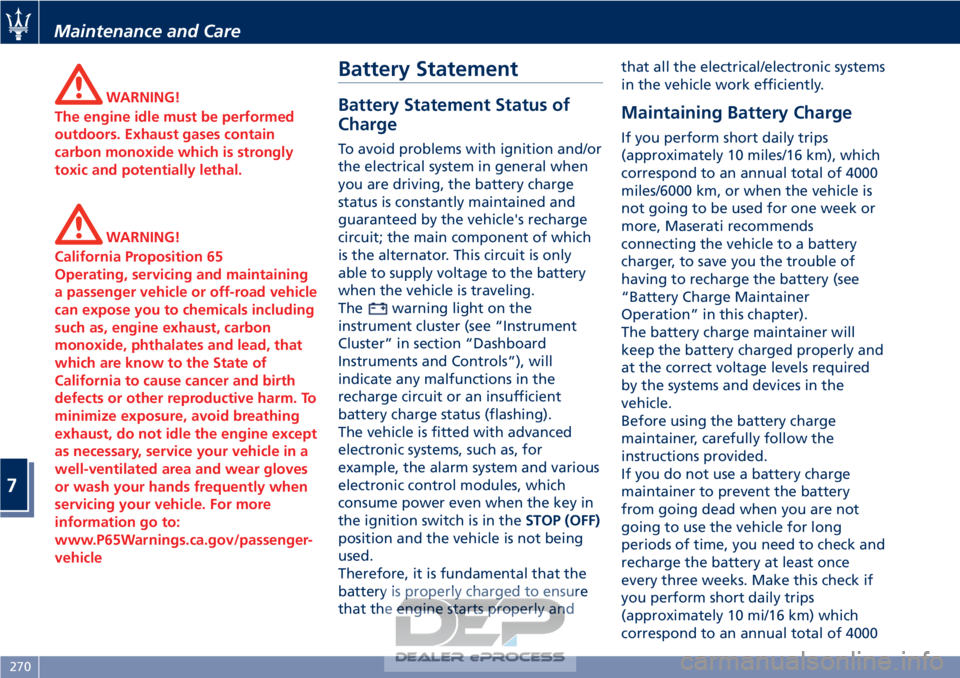
WARNING!
The engine idle must be performed
outdoors. Exhaust gases contain
carbon monoxide which is strongly
toxic and potentially lethal.
WARNING!
California Proposition 65
Operating, servicing and maintaining
a passenger vehicle or off-road vehicle
can expose you to chemicals including
such as, engine exhaust, carbon
monoxide, phthalates and lead, that
which are know to the State of
California to cause cancer and birth
defects or other reproductive harm. To
minimize exposure, avoid breathing
exhaust, do not idle the engine except
as necessary, service your vehicle in a
well-ventilated area and wear gloves
or wash your hands frequently when
servicing your vehicle. For more
information go to:
www.P65Warnings.ca.gov/passenger-
vehicle
Battery Statement
Battery Statement Status of
Charge
To avoid problems with ignition and/or
the electrical system in general when
you are driving, the battery charge
status is constantly maintained and
guaranteed by the vehicle's recharge
circuit; the main component of which
is the alternator. This circuit is only
able to supply voltage to the battery
when the vehicle is traveling.
The
warning light on the
instrument cluster (see “Instrument
Cluster” in section “Dashboard
Instruments and Controls”), will
indicate any malfunctions in the
recharge circuit or an insufficient
battery charge status (flashing).
The vehicle is fitted with advanced
electronic systems, such as, for
example, the alarm system and various
electronic control modules, which
consume power even when the key in
the ignition switch is in the STOP (OFF)
position and the vehicle is not being
used.
Therefore, it is fundamental that the
battery is properly charged to ensure
that the engine starts properly and that all the electrical/electronic systems
in the vehicle work efficiently.
Maintaining Battery Charge
If you perform short daily trips
(approximately 10 miles/16 km), which
correspond to an annual total of 4000
miles/6000 km, or when the vehicle is
not going to be used for one week or
more, Maserati recommends
connecting the vehicle to a battery
charger, to save you the trouble of
having to recharge the battery (see
“Battery Charge Maintainer
Operation” in this chapter).
The battery charge maintainer will
keep the battery charged properly and
at the correct voltage levels required
by the systems and devices in the
vehicle.
Before using the battery charge
maintainer, carefully follow the
instructions provided.
If you do not use a battery charge
maintainer to prevent the battery
from going dead when you are not
going to use the vehicle for long
periods of time, you need to check and
recharge the battery at least once
every three weeks. Make this check if
you perform short daily trips
(approximately 10 mi/16 km) which
correspond to an annual total of 4000
Maintenance and Care
7
270
Page 275 of 296

miles/6000 km. Please note that
allowing the battery to go dead
repeatedly can cause premature wear
on the internal cells and greatly
reduce their life, leading to problems
with the ignition system and other
electrical/electronic systems.
TheAuthorized Maserati Dealer is
available to advise you on how to
recharge your battery correctly and
give you useful information on battery
care and maintenance.
NOTE:
The Authorized Maserati Dealer can
provide you with any information
about the Maserati approved “Battery
Charger and Conditioner”, available in
the “Genuine Accessories” range.
WARNING!
The process of charging or recharging
the battery produces hydrogen, a
dangerous gas that can explode and
cause serious injuries. When charging
or recharging the battery, follow the
recommended precautions at all
times:
• always charge or recharge the
battery in a well-ventilated
environment; •
never charge or recharge a battery
that has frozen: it can explode due
to hydrogen trapped inside the ice
crystals;
• ensure that any sparks or open
flames are nowhere near the battery
while it is charging;
• before using a charger to charge or
maintain the battery charge status,
carefully follow the instructions
provided to ensure the charger is
connected to the battery safely and
correctly.
Battery Charge Maintainer
Operation
Charge Maintainer Socket
Charge maintainer socket is located
inside the trunk compartment, on the
right-hand side. NOTE:
The
Authorized Maserati Dealer can
give you all details concerning the
battery charge maintainer, available
from the "Genuine Accessories" range
with four types of socket, and its use.
Instructions for Use
First connect the battery charge
maintainer to vehicle socket: this
trigger the “Active” stage and the
maintainer can stay connected to
vehicle for a few months with no
problem.
Position the device outside the vehicle,
leaving trunk lid slightly open,
avoiding to squeeze the cable that
gets out of the luggage compartment
and/or damaging the edge seal.
Maintenance and Care
7
271
Page 276 of 296
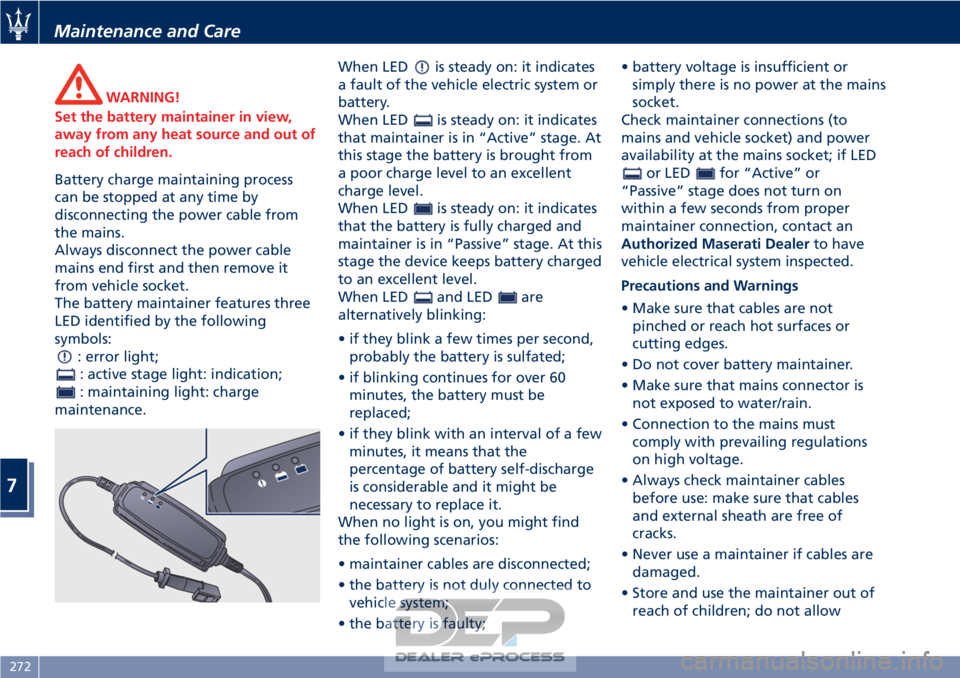
WARNING!
Set the battery maintainer in view,
away from any heat source and out of
reach of children.
Battery charge maintaining process
can
be stopped at any time by
disconnecting the power cable from
the mains.
Always disconnect the power cable
mains end first and then remove it
from vehicle socket.
The battery maintainer features three
LED identified by the following
symbols:
: error light;
: active stage light: indication;
: maintaining light: charge
maintenance. When LED
is steady on: it indicates
a fault of the vehicle electric system or
battery.
When LED
is steady on: it indicates
that maintainer is in “Active” stage. At
this stage the battery is brought from
a poor charge level to an excellent
charge level.
When LED
is steady on: it indicates
that the battery is fully charged and
maintainer is in “Passive” stage. At this
stage the device keeps battery charged
to an excellent level.
When LED
and LEDare
alternatively blinking:
• if they blink a few times per second, probably the battery is sulfated;
• if blinking continues for over 60 minutes, the battery must be
replaced;
• if they blink with an interval of a few minutes, it means that the
percentage of battery self-discharge
is considerable and it might be
necessary to replace it.
When no light is on, you might find
the following scenarios:
• maintainer cables are disconnected;
• the battery is not duly connected to vehicle system;
• the battery is faulty; • battery voltage is insufficient or
simply there is no power at the mains
socket.
Check maintainer connections (to
mains and vehicle socket) and power
availability at the mains socket; if LED
or LEDfor “Active” or
“Passive” stage does not turn on
within a few seconds from proper
maintainer connection, contact an
Authorized Maserati Dealer to have
vehicle electrical system inspected.
Precautions and Warnings
• Make sure that cables are not pinched or reach hot surfaces or
cutting edges.
• Do not cover battery maintainer.
• Make sure that mains connector is not exposed to water/rain.
• Connection to the mains must comply with prevailing regulations
on high voltage.
• Always check maintainer cables before use: make sure that cables
and external sheath are free of
cracks.
• Never use a maintainer if cables are damaged.
• Store and use the maintainer out of reach of children; do not allow
Maintenance and Care
7
272
Page 285 of 296
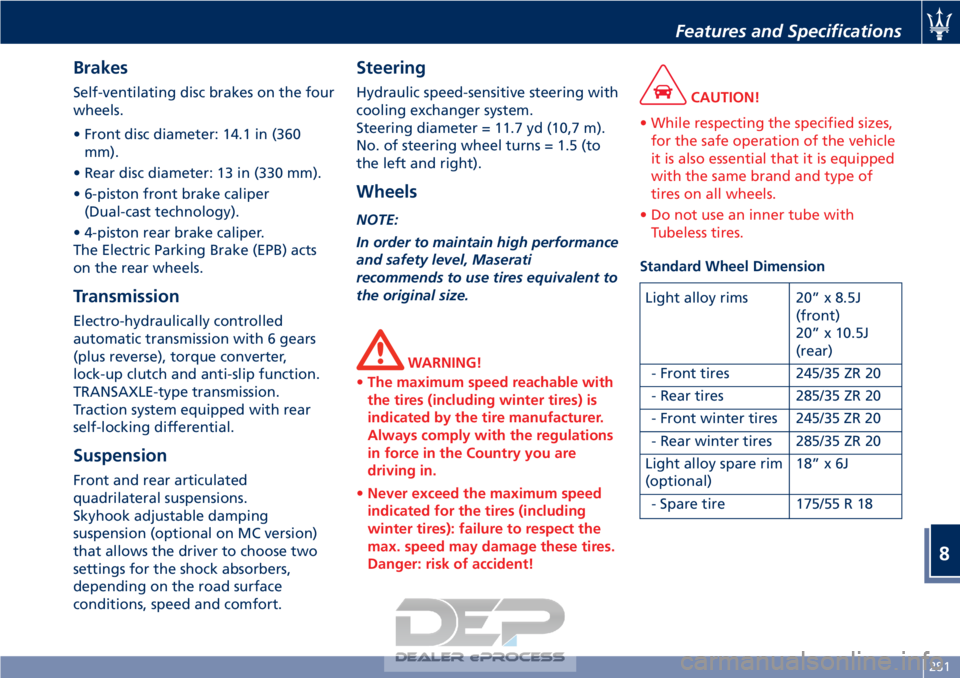
Brakes
Self-ventilating disc brakes on the four
wheels.
• Front disc diameter: 14.1 in (360mm).
• Rear disc diameter: 13 in (330 mm).
• 6-piston front brake caliper (Dual-cast technology).
• 4-piston rear brake caliper.
The Electric Parking Brake (EPB) acts
on the rear wheels.
Transmission
Electro-hydraulically controlled
automatic transmission with 6 gears
(plus reverse), torque converter,
lock-up clutch and anti-slip function.
TRANSAXLE-type transmission.
Traction system equipped with rear
self-locking differential.
Suspension
Front and rear articulated
quadrilateral suspensions.
Skyhook adjustable damping
suspension (optional on MC version)
that allows the driver to choose two
settings for the shock absorbers,
depending on the road surface
conditions, speed and comfort.
Steering
Hydraulic speed-sensitive steering with
cooling exchanger system.
Steering diameter = 11.7 yd (10,7 m).
No. of steering wheel turns = 1.5 (to
the left and right).
Wheels
NOTE:
In order to maintain high performance
and safety level, Maserati
recommends to use tires equivalent to
the original size.
WARNING!
• The maximum speed reachable with
the tires (including winter tires) is
indicated by the tire manufacturer.
Always comply with the regulations
in force in the Country you are
driving in.
• Never exceed the maximum speed
indicated for the tires (including
winter tires): failure to respect the
max. speed may damage these tires.
Danger: risk of accident!
CAUTION!
• While respecting the specified sizes, for the safe operation of the vehicle
it is also essential that it is equipped
with the same brand and type of
tires on all wheels.
• Do not use an inner tube with Tubeless tires.
Standard Wheel Dimension
Light alloy rims 20” x 8.5J (front)
20” x 10.5J
(rear)
- Front tires 245/35 ZR 20
- Rear tires 285/35 ZR 20
- Front winter tires 245/35 ZR 20
- Rear winter tires 285/35 ZR 20
Light alloy spare rim
(optional) 18”x6J
- Spare tire 175/55 R 18
Features and Specifications
8
281
Page 290 of 296

Abbreviations.................7
ABS (Anti-lock Braking System) . . .179
A/C Air Filter Replacement .......263
Accessories Aftermarket Parts and Accessories
Statement .................11
Accident, in the event of ........213
A/C System Maintenance ........262
Airbag.....................46 Air bag System Components .....46
Air bag Warning Light .........66
Passenger Air bag Labels .......18
Supplemental Restraint System
(SRS) .....................46
Air Conditioning Controls .......151
Air Conditioning Distribution .....112
Alarm, Vehicle Security ..........26
ALR (Automatic Locking Retractor) . .43
Assistance ....................9
Assistance, if you need .........9
Audio Controls ...............138
Steering Wheel Audio Controls . .138
Audio, Customer Setting ........147
Audio System ................140
Automatic Transmission ........160
Automatic Transmission Range . .162
AUX, USB and SD Memory Card Ports .....................132
Battery ....................247
Access the Battery ...........226
Jump Start Procedure ........226
Maintenance - Free Battery . . . .247 To Reconnect the Battery
......248
Bluetooth, Customer settings .....147
Bodywork Maintenance and Care . .265 Protection from Atmospheric
Agents ..................265
Useful Advice to Keep the
Bodywork in Good Condition . . .265
Brakes Brake and Stability Control
System ...................177
Brake Fluid Level Check .......242
Brake Overheating ..........182
Parking Brake ..............174
Parking Brake - Manual
Release ..................220
Using the Brakes ............181
Bulb Replacement ............257
Cargo Area .................107
Child Restraint Systems
Children too large for Booster
Seats .....................
56
Infants and Child Restraints .....55
Lower Anchors and Tether for
Children (LATCH) ............57
Older Children and Child
Restraints .................55
Tips on getting the most out of
your child restraint ...........56
Clock, analog ................144
Comfort Pack Front Seats ........76
Driver Memory Seat ..........77
Front Heated Seats ...........76 Console
Central Console Components ....73
Front Dome Console
Components ...............71
Cruise Control ...............185
Cupholders Front Seats Cupholders .......103
Rear Seats Cupholders ........104
Dashboard Components .........70
Data, Technical ..............279
Defroster ...................66
Doors Components .............72
Drive Mode, Controls ..........169
Driving Conditions Before the Trip .............204
Driving at Night ............204
Driving in Fog ..............205
Driving in the Mountains ......205
Driving in the Rain ..........204
Driving on Snow or Ice ........206
Driving through Flooded
Sections ..................206
Safe Driving ...............204
DRL (Daytime Running Light) ......83
Easy Entry/Exit function .........79
EDR (Event Data Recorder) .......52
Emergency Emergency Fuel Filler Door
Release ..................203
Hazard Warning Flasher .......88
In the Event of an Accident . . . .213
Index
9
286